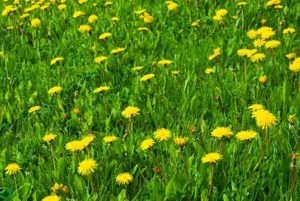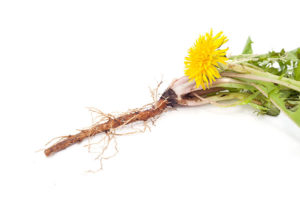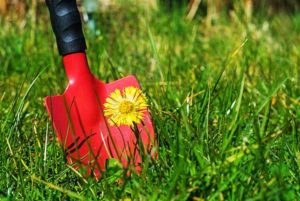Dandelions – How to Prevent, Remove, and Control
If you have a lawn, you may have seen dandelions, those far reaching, daisy-like weeds that come in a variety of shapes and sizes, from stalks covered in downy tufts to yellow rosettes. These ubiquitous yellow weeds pack many vitamins, like A and C, and minerals like folate and calcium, which is why people of the Midwest often use them as food.
For many, dandelions are a part of childhood, whether rubbing the yellow flower on skin or blowing the fuzzy tops away with a wish. However, their seeds blow from lawn to lawn, creating large colonies that can be a nightmare for a homeowner.
Why Do I Have So Many Dandelions in My Yard?
 Dandelions are “perennial weeds,” which means they reappear from taproots deeply buried in the ground. Considering how deep their taproots get, it is best to control them before they go to seed..
Dandelions are “perennial weeds,” which means they reappear from taproots deeply buried in the ground. Considering how deep their taproots get, it is best to control them before they go to seed..
The cause of dandelions in your yard can depend on several factors, such as extended warm periods, excess moisture in the soil, and sunny days, that encourage growth and germination of these weeds.
Dandelion numbers can also be attributed to the previous year’s growing conditions. For example, the wet conditions last spring can influence this spring’s dandelion crop. Grass cannot grow deep enough roots in oxygen-poor, damp soil, which will give dandelions more room to grow in. Unfortunately, this is a problem that returns in successive growing seasons.
Why Are Dandelions Bad for My Lawn?
 Most people are in a love-hate relationship with dandelions. While their bright yellow flowers are pretty and bring some homeowners joy, the difficulty in ridding your lawn of them is only their first issue. First, dandelions compete with your lawn for water. Each time you water your lawn, dandelions absorb moisture that is meant for your turf grass which means your turf grass may not get the water it needs to survive.
Most people are in a love-hate relationship with dandelions. While their bright yellow flowers are pretty and bring some homeowners joy, the difficulty in ridding your lawn of them is only their first issue. First, dandelions compete with your lawn for water. Each time you water your lawn, dandelions absorb moisture that is meant for your turf grass which means your turf grass may not get the water it needs to survive.
Dandelions also form a dense rosette of leaves that can crowd out your turf grass and reduce its strength. If these weeds keep spreading across your lawn every year, they will eventually push out your turf grass and completely seize your yard.
In the early spring, dandelions are a food source for pollinators like bees. While it’s important to let the bees enjoy their food source in the lawn, spreading dandelions attracts more bees, which is a concern if you are allergic to bees, or have children playing outside.
Why Are Dandelions Difficult to Eliminate?
 As perennial weeds, dandelions constantly grow from the same roots in the ground, and are extremely resilient to winter weather. Their survival can be traced to their taproots, which can grow from 6 – 18 inches (45.72 cm) long.
As perennial weeds, dandelions constantly grow from the same roots in the ground, and are extremely resilient to winter weather. Their survival can be traced to their taproots, which can grow from 6 – 18 inches (45.72 cm) long.
As a result, it is difficult for dandelion diggers or shovels to fully uproot dandelions. Cutting a dandelion off at ground level is not sufficient to kill them, and will result in a quick regrowth from the crown. If you do not fully dig the root out of the ground, a new plant will grow, even from as little as one inch of root.
Moreover, dandelions produce large amounts of fluffy, wind-borne seeds that can travel long distances, especially during windy conditions. Dandelions can germinate at any time and almost immediately grow into new plants, and if your climate allows, they will bloom and produce seeds all throughout the year.
Can I Prevent Dandelions from Growing?
There are ways to reduce or prevent dandelions from growing in your lawn. First, keep your lawn on the tall side. Tall grass will both choke out weeds and keep the sun off of dandelion seeds, which will also keep the soil cool. The appropriate length for a Midwestern lawn is about 3 inches (7.62 cm) or taller. We also recommend that you stick to a feeding schedule to maintain a thick, full and tall lawn.
Second, you may want to leave mulched grass clippings on the ground after mowing, as mulch will smother weeds and hinder the growth of new seeds.
Third, consider ways to improve the soil conditions of your lawn. Dandelions thrive in acidic soils, so consider taking a soil test, and then take necessary steps to adjust the pH balance.
Be advised that hand pulling these weeds will not inhibit dandelions since their roots are too deeply embedded in the earth. In the process, you may only remove a part of the taproot and the weeds would only regrow.
What Do I Use to Treat My lawn to Help Prevent Dandelions?
Since dandelions are so annoying to eliminate, it is not easy to completely rid your lawn of them. Your best options to control their spread are to dig them out manually, spot treatments, and spraying herbicides.
A few factors, including the extent of the infestation and your tolerance level will determine how you should best treat them on your lawns. If there are only a few and if you can tolerate them, then you can let them be. However, if the infestation is drastic, consider one of the following options.
Remove the Dandelions Manually
 Removing the dandelion manually is the best option if there are only a few, isolated weeds on your lawn. Remove the entire taproot to prevent regrowing as dandelions can reproduce from the remaining root.
Removing the dandelion manually is the best option if there are only a few, isolated weeds on your lawn. Remove the entire taproot to prevent regrowing as dandelions can reproduce from the remaining root.
A tool specifically designed to uproot the entire taproot is recommended as it will make your work easier and reduce the damage to your lawn. Various dandelion digger models vary in size, shape, grip, cost, effectiveness, and style of removal. Examples include hand-held ones and pole-type diggers that don’t require you to bend.
After removing the entire uproot, patch up any hole or bare spots to avoid weeds from growing on the grass-free area. Always remove dandelions as soon as you see them to avoid an out-of-control situation. Moreover, it will be an easy task if you uproot the taproot when the soil is moist, the dandelion plants are young and haven’t developed seeds.
Spot Treat Dandelions
Spot treatments, which work by chemically attacking the roots of weeds, are the best options for moderate dandelion infestations. It is always best to first consider manual removal for weeds, but if that is not an option, then a variety of spot treatments are available to you.
Not all spot treatments need be chemical. A simple and equally effective treatment is to pour boiling water on the plant and roots. Of course, please take all caution when handling boiling water. If more severe tactics are needed, there are a wide range of natural removal products available.
These products include botanically-based oils, fatty-acid soaps, or acetic acid, an active ingredient in household vinegar. Not all of these products are equal, however, and rounds of testing, or consultation with an expert may be required to find the removal agent that works best for your lawn.
Always remember to carefully read the manufacturer’s instructions and municipality guidelines when considering any form of herbicide, and apply them with caution so that your lawn does not suffer adverse effects. Please remember that several days of treatments may be required to fully remove those plants.
Use Herbicides to Treat the Entire Lawn
While natural removal methods are preferences for most cases, herbicides are handy when weeds fully overrun your lawn. If herbicides are the best course for you, natural or organic products are recommended over synthetic products, as their excessive use can lead to runoff, which will affect nearby waterways, groundwater, and drinking water.
Before applying herbicides, fertilize your lawn with Milogranite, a slow release fertilizer that reduces the potential damage to your lawn’s nutrients, which are at risk from herbicides. The best season to apply herbicides is autumn, usually from October to November, as this season is when dandelions are storing food for winter, and any herbicides applied will be sent straight down to the roots. You won’t see an immediate difference after an initial application, but you will see some changes in the spring.
Consider using a broadleaf herbicide like 2,4-D, dicamba, or MCPP to target the whole dandelion. The herbicide will kill the entire taproot, thus eliminating the dandelion from your lawn. Manufacturer and municipality guidelines always apply.
Finally, always use caution and make sure to apply herbicides under the right conditions. Avoid treatment when winds exceed 5 miles per hour (8.05 km/h) and before the daytime temperature is 85 degrees and above. To avoid reducing the herbicide’s effectiveness, consult forecasts and never spray immediately before or after rain. If it has rained recently, let the grass and ground dry, and then treat.
Do You Need Professional Dandelion Treatment?
Tired of dandelions tarnishing your immaculate lawn? Now is the time to take back control of your lawn! At Ryan Lawn & Tree we offer professional weed control services to target dandelions and other weeds that tarnish your lawn and home.
We would love to help you. Get a Free Estimate today for help with your dandelion treatment needs by a RYAN lawn care expert!









